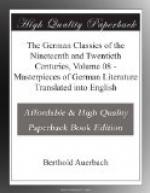The concise thoughts and phrases of the old masters are disturbing to our dreamy musical ear—they are disquieting, they wake us up. Modern musicians are very seldom able to perform impressively this all too concise style of composition because they are no longer accustomed to interchange forte and piano and melodic expression in such short musical sentences; they only have ear and hand for very broad periods, yard-long fortes, pianos and crescendos. By far the greater part of the older chamber-music of the eighteenth century has for our ear something soberly rationalistic. Such imitative music in that age compares with modern imitative music as the painted allegories of the Pigtail age compare with the symbolical paintings of Kaulbach. Johann Jacob Frohberger, court organist to the Emperor Ferdinand III., portrayed the dangers which he incurred crossing the Rhine in an—allemande. To the ear of his contemporaries this portrayal sounded absolutely plain and intelligible. Dietrich Buxtehude described the nature of the planets in seven suites for the piano. The Hamburg organist, Matthias Weckmann, set the sixty-third chapter of Isaiah to music, and the then celebrated missionary to the Jews, Edzardi, bore him witness that in the bass he had painted the Messiah as plainly as if he had seen Him with his own eyes. We have no longer any ear for the comprehension of such rationalistically allegorized music; indeed, we can understand the ear which a former age possessed for it just as little as we can understand the euphony which the ear of the Middle Ages found in Guido’s fourth-harmonies, which now even the dogs cannot put up with.
I shall break off here with the presentation of my documents concerning the alteration of the musical ear. If one tried to expatiate instead of merely suggesting, the sketch would soon grow to be a book.




